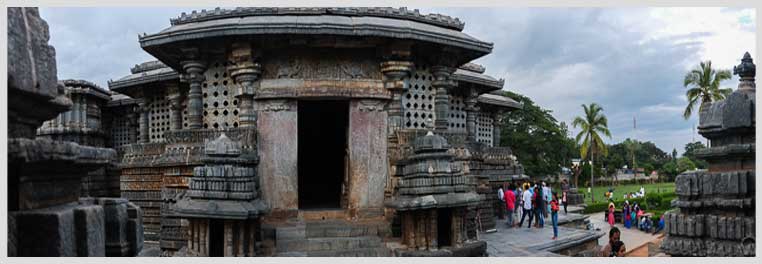HALEBIDKARNATAKA
"A glorious sparkling ruin"

Halebid is situated some 10 miles (16 km) from Belur. The main temple, also built in a star-shaped plan is a magnificent example of Hoysala architecture with a breathtaking collection of friezes - first a row of elephants representing stability, then one of lordly lions and above, scrolls of swift horses. There are scenes from the religious epics representing not only philosophical ideas but also the living conditions of the time. The largest frieze is the most exuberant and based on a heavenly theme - celestial maidens, bedecked in jewels, are seen sitting or standing under pierced canopies in graceful postures.
The original name of Halebid , the ancient capital of the Hoysalas, was Dwarasamudram, "gateway to the sea". After its sack by the Delhi Sultanate, it came to be known as Halebid, "old Capital". There were many temples and palaces here but few survived the invasion. The magnificent Hoysaleswara temple is very similar to the temple at Belur, though different in detail work. It is set on the same star - shaped platform ascended by a short flight of steps. The palace once stood nearby, connected to the temple by a passage. A Nandi bull, the mount of Lord Shiva, stands guard at the entrance. This temple is about 800 years old, although not wholly in ruins. Only one bracket figure remains, though the relief carvings on the walls are as profuse and complex as at Belur. Among the carvings are scenes of many historical battles, of the child Krishna's frolics, Shiva and Parvati's embrace and Ravana hoisting Mount Kailash. The Hoysalas, traditional enemies of the Chalukyas, ruled this part of the Deccan between the 11th and 13th centuries. They rose to prominence first under leadership of their ruler Tinyaditya and later under king Bittiga, better known as Vishnuvardhana. It was during this period when the Hoysalas established their supremacy that the temples of Belur and Halebid were built.



